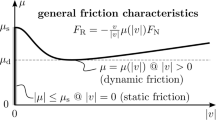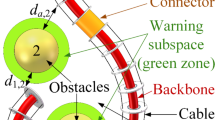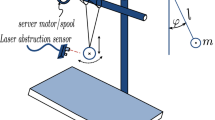Abstract
In this paper, a formulation for a spatial sliding joint is derived using absolute nodal coordinates and non-generalized coordinate and it allows a general multibody move along a very flexible cable. The large deformable motion of a spatial cable is presented using absolute nodal coordinate formulation, which is based on the finite element procedures and the general continuum mechanics theory to represent the elastic forces. And the nongeneralized coordinate, which is related to neither the inertia forces nor the external forces, is used to describe an arbitrary position along the centerline of a very flexible cable. Hereby, the non-generalized coordinate represents the arc-length parameter. The constraint equations for the sliding joint are expressed in terms of generalized coordinate and nongeneralized coordinate. In the constraint equations for the sliding joint, one constraint equation can be systematically eliminated. There are two independent Lagrange multipliers in the final system equations of motion associated with the sliding joint. The development of this sliding joint is important to analyze many mechanical systems such as pulley systems and pantograph-catenary systems for high speed-trains.
Similar content being viewed by others
References
Wang, Y.M.: The transient dynamics of a cable-mass system due to the motion of an attached accelerating mass. Int. J. Solids Struct. 37, 1361–1383 (2000)
Al-Qassab, M., Nair, S.: Dynamics of an elastic cable carrying a moving mass particle. Nonlinear Dyn. 33, 11–32 (2003)
Siddiqui, S.A., Golnaraghi, M.F.: Dynamics of a flexible cantilever beam carrying a moving mass. Nonlinear Dyn. 15, 137–154 (1998)
Hwang, R.S., Haug, E.J.: Translational joints in flexible multibody dynamics. Mech. Struct. Mach. 18(4), 543–564 (1990)
Shabana, A.A.: Computer implementation of the absolute nodal coordinate formulation for flexible multibody dynamics. Nonlinear Dyn. 16, 293–306 (1998)
Bauchau, O.A.: On the modeling of prismatic joints in flexible multibody systems. Comput. Methods Appl. Mech. Eng. 181, 87–105 (2000)
Sugiyama, H., Escalona, J., Shabana, A.A.: Formulation of three-dimensional joint constraints using absolute nodal coordinates. Nonlinear Dyn. 31, 167–195 (2003)
Seo, J.H., Jung, I.H., Han, H.S., Park, T.W.: Dynamic analysis of a very flexible cable carrying a moving multibody system. Trans. Korean Soc. Noise Vib. Eng. 14(2), 150–156 (2004)
Seo, J.H., Sugiyama, H., Shabana, A.A.: Three-dimensional large deformation analysis of the multibody pantograph/catenary systems. Nonlinear Dyn. 42, 199–215 (2005)
Huston, R.L., Passerello, C.E.: Validation of finite segment cable models. Comput. Struct. 15(6), 653–660 (1982)
Winget, J.M., Huston, R.L.: Cable dynamics—a finite segment approach. Comput. Struct. 6, 475–480 (1976)
Kamman, J.W., Huston, R.L.: Multibody dynamics modeling of variable length cable systems. Multibody Syst. Dyn. 5, 211–221 (2001)
Yoo, W.S., Lee, S.J., Sohn, J.H.: Large oscillations of a thin cantilever beam: physical experiments and simulation using absolute nodal coordinate formulation. Nonlinear Dyn. 34, 3–29 (2003)
Escalona, J.L., Hussien, H.A., Shabana, A.A.: Application of the absolute nodal coordinate formulation to multibody system dynamics. Nonlinear Dyn. 16, 293–306 (1998)
Shabana, A.A., Yakoub, R.Y.: Three dimensional absolute nodal coordinate nodal coordinate formulation for beam elements: theory. J. Mech. Des. 123, 606–613 (2001)
Shabana, A.A., Yakoub, R.Y.: Three dimensional absolute nodal coordinate nodal coordinate formulation for beam elements: implementation and applications. J. Mech. Des. 123, 614–621 (2001)
Mikkola, A.M., Shabana, A.A.: A non-incremental finite element procedure for the analysis of large deformation of plates and shells in mechanical system applications. Multibody Syst. Dyn. 9, 283–309 (2003)
Bonet, J., Wood, R.D.: Nonlinear Continuum Mechanics for Finite Element Analysis. Cambridge University Press, Cambridge (1997)
Kenneth, H.H., Thornton, E.A.: The Finite Element Method for Engineers. Willey, New York (1995)
Shabana, A.A.: A QR decomposition method for flexible multibody dynamics. Technical Report No. MBS97-2-UIC, Department of Mechanical Engineering, University of Illinois at Chicago (1997)
Haug, E.J.: Computer-Aided Kinematics and Dynamics of Mechanical Systems. Allyn and Bacon, Boston (1989)
Author information
Authors and Affiliations
Corresponding author
Rights and permissions
About this article
Cite this article
Lee, SH., Park, TW., Seo, JH. et al. The development of a sliding joint for very flexible multibody dynamics using absolute nodal coordinate formulation. Multibody Syst Dyn 20, 223–237 (2008). https://doi.org/10.1007/s11044-008-9109-3
Received:
Accepted:
Published:
Issue Date:
DOI: https://doi.org/10.1007/s11044-008-9109-3




